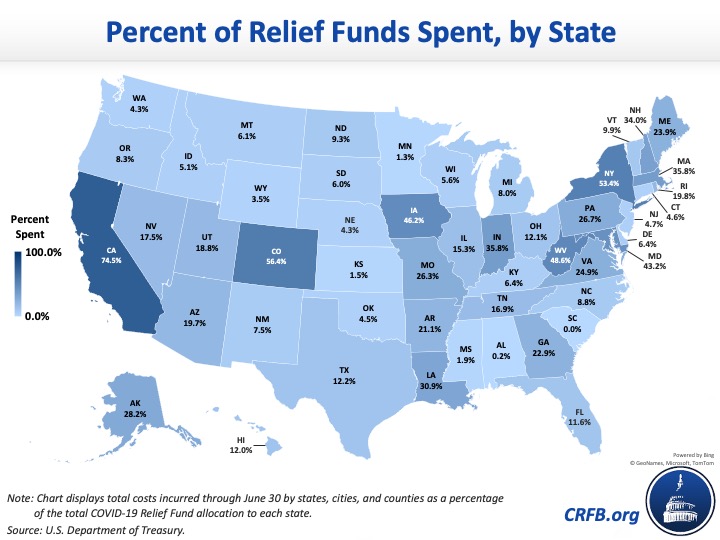How Much Have States Spent from the Coronavirus Relief Fund?
The Coronavirus Aid, Recovery, and Economic Security (CARES) Act created a $150 billion Coronavirus Relief Fund to provide direct payments to states, localities, tribal areas, and territories fighting the COVID-19 pandemic. As of August 4, $149.5 billion of those funds had been disbursed, with $139 billion going to state and local governments, $7.5 billion to tribal areas, and $3 billion to territories and the District of Columbia. But as of the end of June, only one-quarter of the money has been spent by those governments.
States and local governments can spend the money for COVID-19 related costs between March and December of 2020 that were not already in a previous budget. Nearly all the funds have been disbursed to states, counties, and cities by population (with a minimum of $1.25 billion per state), but according to an interim report from the Treasury's Office of the Inspector General (OIG), just $34.2 billion has been spent so far – 25 percent of the $139 billion sent to states and local governments.

This blog post is a product of the COVID Money Tracker, a new initiative of the Committee for a Responsible Federal Budget focused on identifying and tracking the disbursement of the trillions being poured into the economy to combat the crisis through legislative, administrative, and Federal Reserve actions.
While a quarter of the funds have been spent so far, spending differs dramatically by state. For example, California state (together with its cities and counties) has spent 75 percent of its money – $11.4 billion out of $15.3 billion, whereas South Carolina has spent less than 0.05 percent of its money – $763,028 out of $2 billion, all by one county. Other heavily populated states including Texas, Florida, and New York have spent 12.2, 11.6, and 53.4 percent of their allocations, respectively.

There is also diversity in how much has been spent within states. For example, California has spent 100 percent of the money given to the state government itself, but most cities and counties within California have spent less than half of their funds. Michigan state has spent only 3 percent of its funds, while Detroit has spent over 90 percent of its funds, averaging out to 8 percent for the state.
It is important to note that Treasury's report only accounts for funds that have already been spent, not funds earmarked for future purposes. States or local governments may have already allocated the funds, but not disbursed them yet. For example, funds committed to support virtual or in-person education likely will not be expended until the fall and are not included in Treasury's report. The National Association of State Budget Officers (NASBO) notes that if Treasury included these future commitments in its reporting, the percentage of COVID-19 relief funds that states have used or have committed to use would be closer to 75 percent.
We will continue to track COVID relief funds in our main COVID Money Tracker table, updated regularly.


